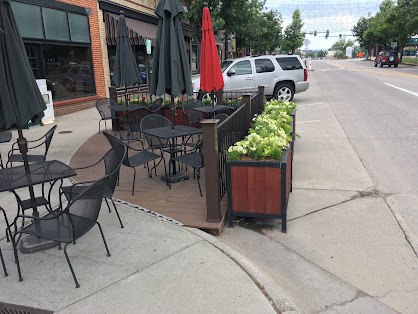 |
| Astronaut Tim Kopra took this night photo of Chicago from space. Beginning in the 1920s, Chicago became a center of research into morphology as a crime factor - photo courtesy NASA |
by Gregory Saville
The promise of scientific discoveries never guarantees positive results. That is up to us and the wisdom of our choices. But without rational thinking, data and evidence, and decent research on the problems of our day, we cannot expect to reap the rewards that proliferate in the sciences. This especially applies for city building and crime prevention.
That brings me to what social geographers call urban morphology. Urban morphology is the scientific study of the macro geometry and physical form of cities and towns, such as street patterns, land uses, and population densities – basically modern urban land use planning. It was during my university classes in urban morphology that I first learned why architects and urban planners think so differently.
An architect might design building windows facing the street to improve natural surveillance and decrease crime. But a traffic engineer might design a wide, one-way street to speed vehicles from one region of the city to another. Speeding cars make a street inhospitable and unwalkable, in which case no one bothers to look outside. So much for natural surveillance.
Many times I have been asked to look at street crime and noted empty sidewalks, loud vehicle noise from speeding cars, and high vehicle speeds on a wide, one-way street. Morphology matters and recent criminological research confirms it.
 |
| The traditional suburban cul de sac - Photo by Michael Tuszynski on Unsplash |
CUL-DE-SACS
Take the cul de sac. Some criminologists claim that cul de sacs are the safest places to live because we get to know our neighbors which leads to territorial control and that cuts crime. Having lived on a cul de sac, I often questioned those assumptions. Were those assumptions actually based on scientific data or were they just a pocketful of anecdotes?
In environmental criminology, I learned that cul de sacs were places of lower crime due to limited permeability, controlled access, and increased territoriality. Some studies supported that hypothesis.
Then new research challenged that hypothesis. One South Korean study showed how cultural factors can exacerbate, or mitigate cul de sac risks. Another study by Mateja Mihinjac in her criminology graduate research also challenged the cul-de-sac-is-good hypothesis. Her research indicated they had no impact. All this, of course, is how science is supposed to proceed:
Hypotheses are tested --> old theories fall --> new theories emerge.
Then I read the work of civil engineer, Charles Marohn, someone with decades of experience designing roads and streets.
Marohn and his colleagues examined the fiscal side of street designs, including cul de sacs. They looked at the street engineering of cul de sacs and compared the fiscal costs of construction, maintenance, replacement, asphalt, and extruded curb costs, with other types of streets. The results were not encouraging.
 |
| Cul de sacs were envisioned as safe areas - Photo by Stephen Andrews on Unsplash |
Another urban planner re-examined Marohn’s hypotheses and studied cul de sac street design costs in his own city. His research too was shocking.
It turns out that cul de sacs make no fiscal sense. They are expensive to construct and difficult to maintain. Cities end up in the red when they attempt to cover costs. Tax revenue from residents does not come close to paying for cul de sacs. Costs for maintaining cul de sacs balloon as they age and they will eventually need huge property tax increases or federal subsidies – neither of which is likely. So not only are cul de sacs not exactly the crime panacea first thought, they are also fiscally unsustainable.
STRONG TOWNS MOVEMENT
This research is a product of the Strong Towns movement. Strong Towns researchers raise all sorts of important morphology questions that pertain to crime. For example, what about all the excessive parking lots in cities and their contribution to safety, crime, and fiscal sustainability?
 |
| Many modern cities have excessive parking, mostly unused |
In Dallas, Texas 25% of the entire downtown land use is for parking cars, often the same empty parking lots where people are assaulted and cars are easily stolen. When Strong Town researchers dug into the municipal costs to cover car parking, the result was alarming. These are costs that could be better spent on housing the homeless, responding to toxic street drugs, or better public transit.
The Strong Town advocates have some intriguing design answers. Installing curbside patios to replace downtown parking spots is one type of repurposing that can help. For example, Toronto instituted curbside patios and found they produce 49 times more money than the street parking spots they replaced – again, money that might be tapped for better livability results.
 |
| Street patios are inexpensive, bring more fiscal returns than parking spots, and provide a popular livability option |
Charles Marohn is the president of the Strong Town movement and his book, The Confessions of a Recovering Engineer is a must for those interested in city design and SafeGrowth.
It emphasizes the role of scientific research and evidence in urban planning and design if we are to reap the kinds of successes in crime prevention that we see in other branches of science.
I would encourage people to first read “Strong Towns” by Chuck Marohn; it better explains the concept and philosophy behind the Strong Towns movement-
ReplyDeleteI will bet that it resonates loudly with SafeGrowth advocates.
Better yet, check out their social media pages, check out their website, and check out the materials in their toolkit.
Strong Towns and SafeGrowth go together like peanut butter & jelly!
Peanut butter, jelly on sourdough toast, to be precise. Yes, Anon, I agree the two seem to go together nicely. Aligned philosophies from two different worlds.
ReplyDelete